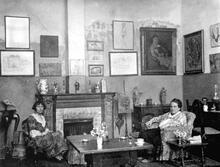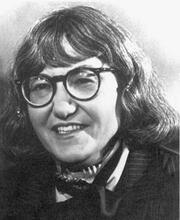Rebekah Gumpert Hyneman
In her poems, essays, and short stories, Rebekah Gumpert Hyneman urged her fellow Jews to resist assimilation and understand the power and beauty of their tradition. Hyneman grew up in a sheltered, middle-class environment, but after her husband’s disappearance on a business trip, she struggled to raise their two sons alone. She regularly returned to the theme of characters who refuse the comfortable life that assimilation might bring and who are then rewarded for their steadfast faith. In her series of poems, “Female Scriptural Characters,” she highlighted the feminine virtues of Esther, Ruth, Deborah, and the Matriarchs, among others. Her writing praised a model of femininity that she herself, an independent woman working to support her children, could not follow, but despite this deep contradiction, her work was popular with both Jews and Gentiles.
Article
Rebekah Gumpert Hyneman was best known to mid-nineteenth-century American Jews as the author of The Leper and Other Poems (1853). However, she also published stories, poems, and essays in the Occident and American Jewish Advocate, the Masonic Keystone and Mirror, and other periodicals.
Born on September 8, 1812, to a Jewish father and a non-Jewish mother, Rebekah (Gumpert) Hyneman led a sheltered life in and around Philadelphia. Her marriage to Jewish businessman Benjamin Hyneman intensified her feelings about Judaism. Her husband disappeared on a business journey after only five years of marriage, yet for the rest of her life Rebekah remained committed to “the faith of [her] adoption.” Rebekah and Benjamin Hyneman had two sons, Elias and Barton. Elias, the elder, born in 1837, was a Union cavalry soldier who died in 1865 in Georgia’s Andersonville Prison. Hyneman was close to her sister Sarah, who married Benjamin Hyneman’s brother Leon. Leon Hyneman was an active Mason who founded the Masonic Keystone and Mirror in 1852.
Hyneman’s devotion to Judaism is evident in much of her writing. “The Chosen,” for example, published in Leper, articulates concern for Jews who forsake Judaism because of “temptations” and an “oppressor’s hand.” “The Lost Diamond,” a story published in Occident in 1862, makes those temptations concrete, in the form of material well-being. The characters resist: They are unwilling to pay the price, conversion to Christianity. Ultimately, these faithful Jews are rewarded with wealth and love.
In a significant number of her works, Hyneman promoted ideals of Jewish women’s behavior. “Female Scriptural Characters,” a series of poems that appeared in Occident between 1846 and 1850 (subsequently included in Leper), pays homage to fourteen women including Sarah, Rebekah, Ruth, Esther, Deborah, and Judith. Repeatedly, Hyneman emphasized the womanliness of these faithful Jews, particularly by noting their piety and valor as well as their adherence to white middle-class American codes of female behavior. In “Miriam’s Song,” Miriam loudly proclaims, “Shout ye his name—the Lord our God is one!” but the speaker of the poem concludes with, “Oh, woman! weak and powerless, yet unto thee is given/The task to prune the budding branch, and bid it bloom for heaven.” Such rhetoric reinforced, more than it challenged, cultural ideals of womanhood.
Hyneman herself rarely defied expectations in her adherence to mid-nineteenth-century conventions of Jewish and American womanly propriety, in either her personal conduct or her writing. Yet she was one of a small number of American Jewish women of the time who published their work. She took that bold step into the public arena in order to share with other American Jews her belief in the significance of Judaism, as well as to educate uninformed, and even antisemitic, non-Jews.
Rebekah Gumpert Hyneman died on September 10, 1875.
Selected Works
“Female Scriptural Characters.” Occident and American Jewish Advocate. Series (1846–1850);
The Leper and Other Poems (1853); “The Lost Diamond.”
Occident and American Jewish Advocate 19 (March 1862): 551–555, and 20 (April): 10–15, and 21 (May): 71–75, and 22 (June): 117–123, and 23 (July): 163–171.
Cohen, Nina Morais. “Rebekah Hyneman.” American Jews Annual 5646 (1885).
JE.
Lichtenstein, Diane. Writing Their Nations: The Tradition of Nineteenth-Century American Jewish Women Writers. Bloomington: Indiana University Press, 1992.
Marcus, Jacob Rader, ed. The American Jewish Woman 1654–1980: A Documentary History. New York: Ktav Pub & Distributors Inc, 1981.Morais, Henry Samuel. The Jews of Philadelphia: Their History from the Earliest Settlements to the Present Time.Ann Arbor: University of Michigan Library, 1894.
Umansky, Ellen, and Dianne Ashton, eds. Four Centuries of Jewish Women’s Spirituality: A Sourcebook. Boston: Beacon Press, 1992.
UJE.





